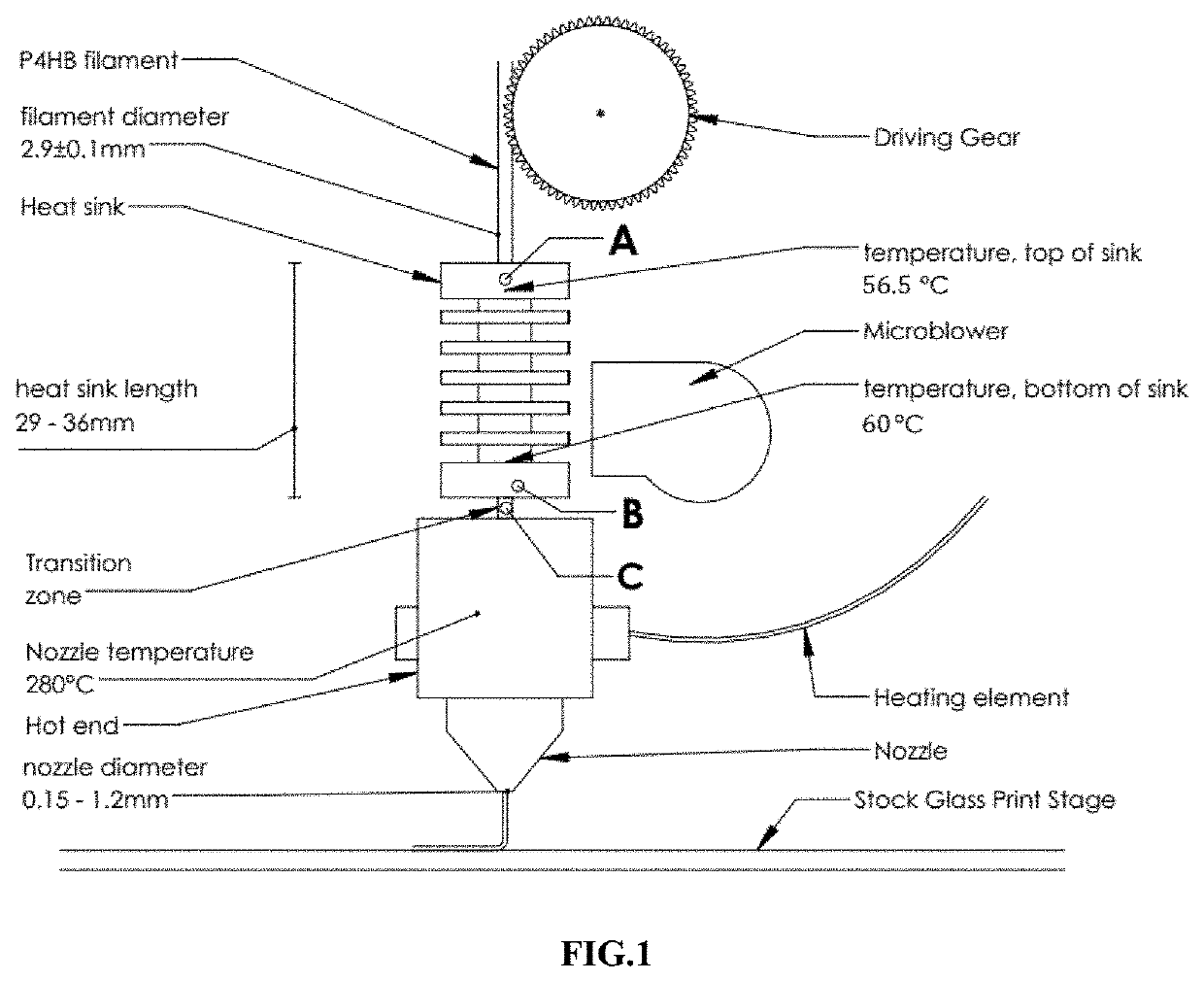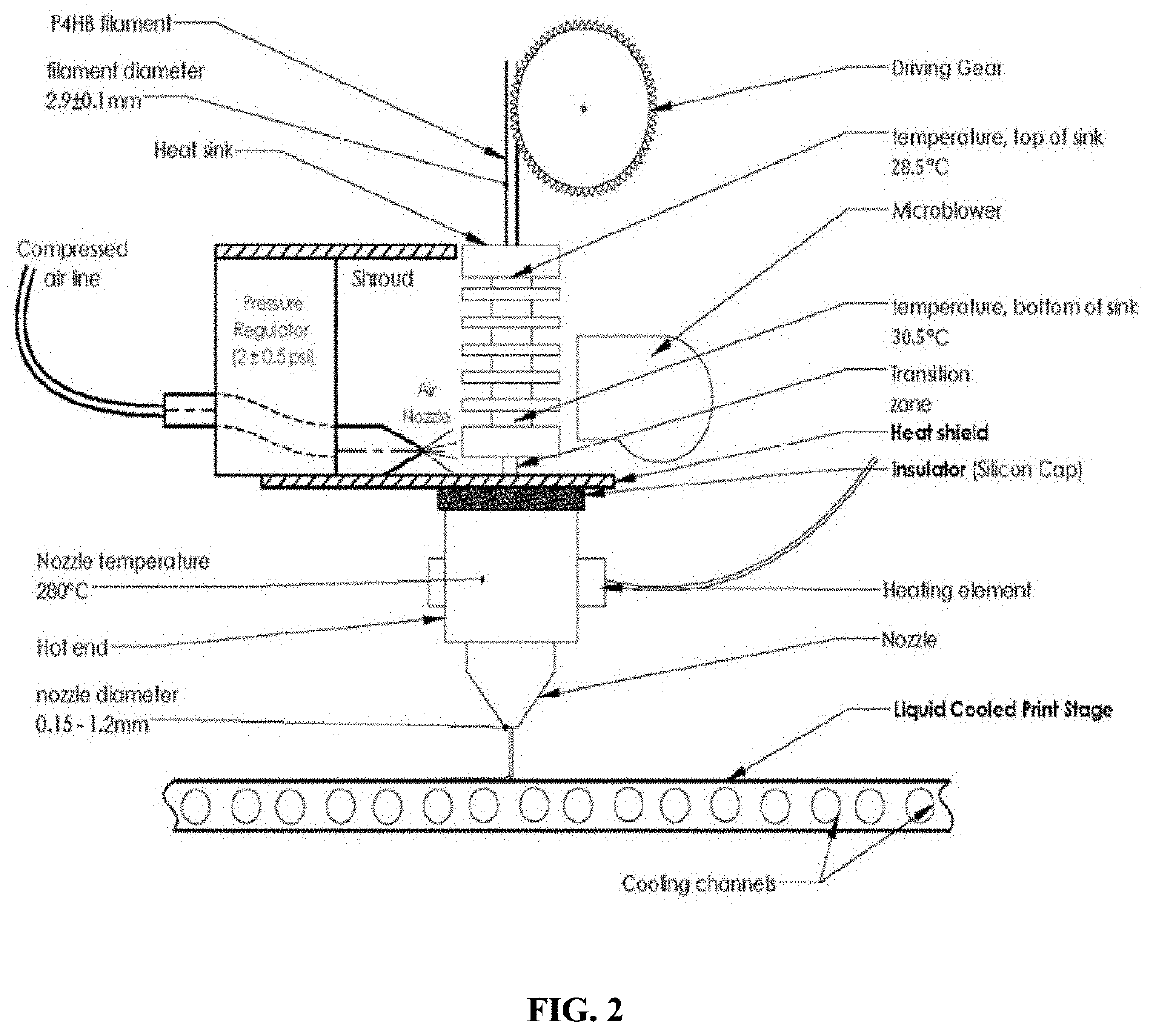Methods for 3D printing of poly-4-hydroxybutyrate and copolymers
a technology of polyhydroxybutyrate and polymer, applied in the direction of additive manufacturing process, prosthesis, catheter, etc., can solve the problems of not disclosing equipment not disclosing equipment, etc., to improve the print quality of objects, reduce the molecular weight of polymers, and rapid solidification of polymers
- Summary
- Abstract
- Description
- Claims
- Application Information
AI Technical Summary
Benefits of technology
Problems solved by technology
Method used
Image
Examples
example 1
l 3D Printing of a P4HB Meniscal Implant by FFF
[0145]In this example, the same setup parameters were used as in Comparative Example 1 above. However, multiple modifications were made to the 3D printer as follows. A shroud was attached to the printer head which incorporated a compressed air line and nozzle to focus cooling air on the lowest fin of the heat sink. A heat shield was located in the transition zone between the hot end and the heat sink to prevent the compressed air from hitting the hot end and printing stage. An insulator, made from silicon, was located between the hot end and the heat shield to protect the heat shield from thermal deformation. And, the printing stage was replaced with an aluminum stage that could be cooled, and that had a flatter surface. The stage was maintained at 22° C. during printing. The modified equipment set up is shown in FIG. 2.
[0146]P4HB filament with an average diameter of 2.85 mm, and a polymer Mw of 340 kDa, was used for printing. Directing...
example 2
ng of a P4HB Mesh by FFF
[0148]A P4HB mesh with a crisscross pattern was printed with the FFF 3D printer set up shown in FIG. 2 using the following method. The desired crisscross pattern, with a line to line distance of 2 mm and consecutive layers set at 45 degrees to each other, was transformed into an STL file, and rendered into a two-slice 3D printing profile (Matter Control) with a slice (layer) height of 0.25 mm. Unoriented P4HB monofilament (Mw=340 kDa) with an average diameter of 2.85 mm was fed into the printer at a feed rate of 0.22 mm / s, heated in the hot end to a temperature of 270° C., and printed from a nozzle with an orifice diameter of 0.3 mm and a print speed of 6.5 mm / s. The stage was made from aluminum, and was maintained at a temperature of 22° C. during printing. Adhesion of the first printed layer to the aluminum stage was excellent, and very uniform as shown in FIG. 7A. The temperature at the bottom of the heat sink was maintained at 30° C. by directing compress...
example 3
ng of P4HB by Fused Pellet Deposition (FPD)
[0149]A P4HB object was printed by FPD using the equipment set up shown in FIG. 8A comprising a reservoir with a heated jacket and a pressure line and cap, a nozzle located at the bottom of the reservoir, and a moving stage. The reservoir was charged with P4HB pellets (Mw 150 kDa), pressurized with compressed air to a pressure of 9 bars (900 kPa), and the pellets were heated to 120° C. Under these conditions, it was possible to print good quality objects comprising P4HB when the diameter of the orifice in the printer nozzle was 0.2 mm (FIG. 8B; right). When the temperature exceeded 180° C., the printed structure warped and had poor resolution (FIG. 8B; middle and left).
PUM
| Property | Measurement | Unit |
|---|---|---|
| Temperature | aaaaa | aaaaa |
| Temperature | aaaaa | aaaaa |
| Temperature | aaaaa | aaaaa |
Abstract
Description
Claims
Application Information
 Login to View More
Login to View More - R&D
- Intellectual Property
- Life Sciences
- Materials
- Tech Scout
- Unparalleled Data Quality
- Higher Quality Content
- 60% Fewer Hallucinations
Browse by: Latest US Patents, China's latest patents, Technical Efficacy Thesaurus, Application Domain, Technology Topic, Popular Technical Reports.
© 2025 PatSnap. All rights reserved.Legal|Privacy policy|Modern Slavery Act Transparency Statement|Sitemap|About US| Contact US: help@patsnap.com



